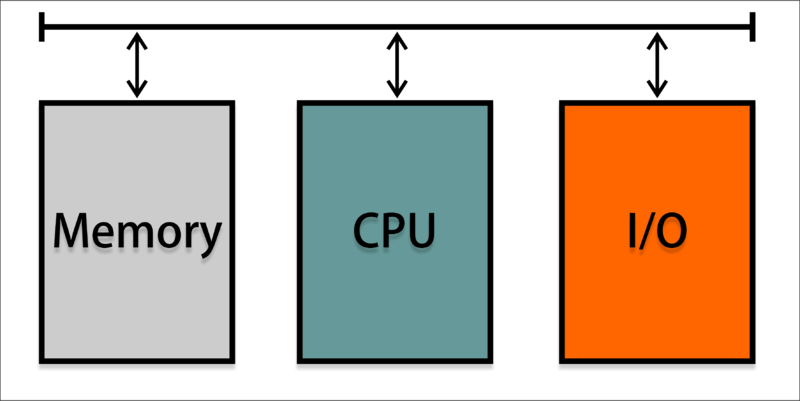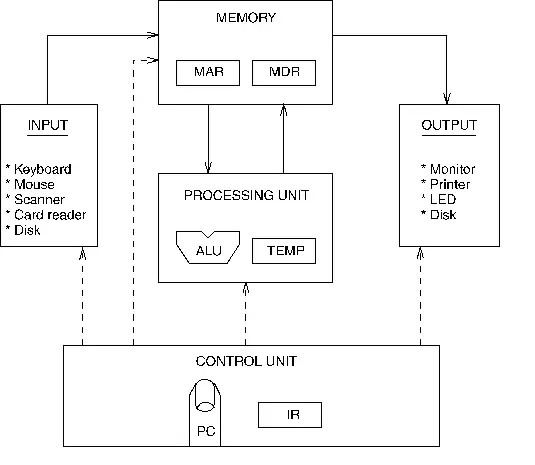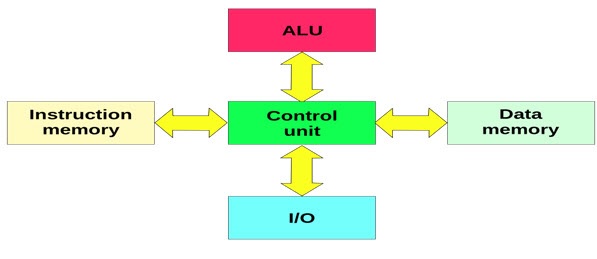Difference between revisions of "Fundamentals of computer organisation and architecture"
Mfrederick (talk | contribs) (→3 Box Model) |
(→Address Bus) |
||
| Line 24: | Line 24: | ||
==Address Bus== | ==Address Bus== | ||
| − | Carries addresses from the processor to main memory and other device controllers. | + | Carries addresses from the processor to main memory and other device controllers, such as addresses to take information from and send information to on the hard drive of a computer, as well as the addresses of anywhere else in the computer data may need to be sent to.. |
==Data Bus== | ==Data Bus== | ||
Revision as of 22:40, 5 March 2017
Contents
3 Box Model
Processor
The CPU is what processes the data, it is the brain of the computer. It is responsible for executing commands, running programs and controls parts of the system and monitors them. The CPU is the most complex part of any system but it is a big Finite State Machine.
Main Memory
Memory is the simplest part of the computer as it stores data temporally, it acts as a post it note for the computer and when the computer is turned off, it is erased (this means that it is volatile).
I/O
Input/Output or I/O is the communication between a device such as a computer and external devices. The Inputs are information received by the computer from external devices and the Output is the information sent by the computer out to external devices.
I/O devices are hardware used by a human in order to interact with the computer. For example a keyboard and mouse are used to operate computers and are necessary for use to be able to use a computer efficiently, these are input devices, while the computer sends out information to the monitors in order for the person using the computer to see what is happening, information is also sent from the computer to printer telling it where to apply ink to the page and what colors to use when printing, these are output devices. There are also devices used to communicate between computers, such as modems or network cards, devices like these act as both input and output devices.
Input devices are devices that take physical movements from the user and convert those inputs into input signals which the computer can understand.
Output devices are devices that take signals from the computer and and convert them into something the user can understand, e.g the display on a monitor or the page printed by the printer.
extended model with split I/O
System Bus
Control Bus
The control bus Carries control signals to and from the processor to main memory and other device controllers.
Address Bus
Carries addresses from the processor to main memory and other device controllers, such as addresses to take information from and send information to on the hard drive of a computer, as well as the addresses of anywhere else in the computer data may need to be sent to..
Data Bus
Carries data to and from main memory and other device controllers and instructions from memory to the processor.
Stored Program Concept
von Neumann Architecture
von Neumann Architecture is a type of computer architecture, based on the design created by John von Neumann in 1945.
Computer systems that use von Neumann Architecture contain three main components; the central processing unit (CPU), memory, and input/output devices (I/O), which are all connected together using the system bus.
The memory stores the information (data/program). The processing unit handles computation/processing of information. The Input receives the information from input devices such as mouse and keyboard. The Output sends information out to devices such as the monitor or printer. The Control unit endures that the other components are performing their tasks correctly.
Harvard Architecture
Harvard Architecture is a type of computer architecture based on the Harvard Mark 1 relay-based computer, which stored instructions on punched tape and data in electro-mechanical counters.
Computer systems that use Harvard Architecture have their memory split into two parts. One part of the memory is used for data storage and handling, while the other half is used to run programs. Each part of the memory is accessed with a different bus, meaning the central processing unit can fetch data and instructions at the same time. This also decreases the chance of a program corruption.
Harvard Architecture is sometimes used within the central processing unit to handle its catches, but it is used less with main memory because of its complexity and cost.


